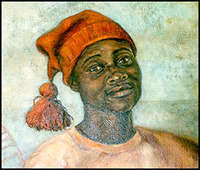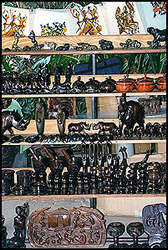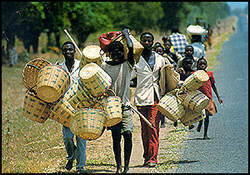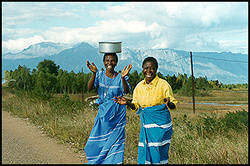 ART & CULTURE ART & CULTURE |
 ART ART |

Malawian artists who have achieved recognition for their work inside the country and abroad include Kay Chirombo, Willie Nampeya, Cuthy Mede, Charley Bakari and Louis Dimpwa. Between them they represent various media, producing carvings in stone and wood, batiks and paintings. Some critics and commentators have discussed the evolution of a distinct Malawian style or ‘school’ but other parts of Africa have precluded this.
Of the painters and sculptors inside Malawi, Cuthy Mede is possibly the best known, especially since he gave up his lecturing job to open Galerie Africaine in Lilongwe, the first high-profile art gallery of the country. Many of the works on display and for sale are his own, but some are by other local artists. He is also actively involved in the development and promotion of Malawian art within the country and around the world.
Among places in Malawi where you have the possibility to see artists in action, and buy their work, is Mua Mission (in Central Malawi, on the road between Salima and Balaka). A missionary named Father Boucher has established a school and studio here, providing the space and encouragement for local artists to explore and develop their own distinctive styles. Most of the artists work in wood, and while some of the work is strongly influenced by Western Christianity, other pieces are of traditional African Design.

Malawians are skilled craftmen who enjoy producing beautiful things. You may see a carver plying his craft in a roadside village, or a basket weaver by the Lakeshore.
Ebony will be delicately carved to form a bridge of elephants, and this is a highly sought after item. Wood and soapstone are used in animal carvings – some very realistic, others simple and streamlined. You will find these pieces on sale in Blantyre, and most of the Lakeshore village. Traditional cane work is found all over Malawi, and a popular item is a replica of the fish trap used at the lake.
| 
Raffia, plain or bright dyed, is made into tea trays, table mats and beach hats. Vividly dyed glass is woven into patterned mats of varying shapes.
Very attractive and hard-wearing are the floor mats, circular or rectangular, which are made from sisal, palm and maize leaves. You will find these in the curio shops, and also on display at colourful roadside stalls on the way to the Lake.
In the range of handcrafts available, from ebony to simple beadwork, there is ingenuity and charm, and you will be tempted to take away many a memento of your visit.
 CULTURE CULTURE |
African are generally very easy-going towards foreigners, and any social errors that you might make are unlikely to cause offence. Having said that, they are a few things that are frowned upon wherever you go. These include: public nudity, open displays of anger, open displays of affection and vocal criticism of the government or country.
On top of these basics, a few straightforward courtesies may greatly improve your chances of acceptance by the local community, especially in rural areas. Pleasantries are taken quite seriously, and it’s essential to greet someone entering or leaving a room. Great emphasis is also placed on handshakes.
 PHOTOGRAPHY PHOTOGRAPHY |

The best time to take photographs on sunny days are the first two hours after sunrise and the last two before sunset. This take advantage of the colour-enhancing rays cast by a sun sitting low on the horizon.
|

